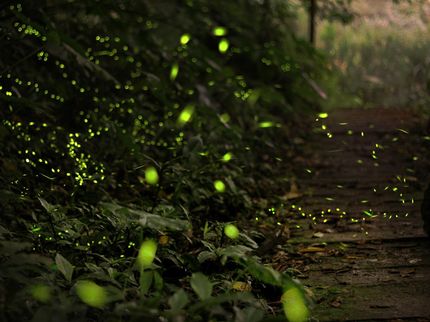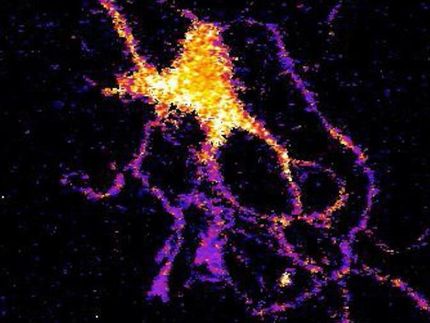Fruit flies have latent bioluminescence
New findings hold promise for expanded use of bioluminescence imaging tools
New research from scientists at the University of Massachusetts Medical School shows that fruit flies are secretly harboring the biochemistry needed to glow in the dark —otherwise known as bioluminescence.
The key to activating this latent ability is a novel synthetic analog of D-luciferin developed at UMMS. The findings, published in the journal Proceedings of the National Academy of Sciences, suggest that the inherent biochemistry needed for bioluminescence is more common than previously thought. Synthetic luciferins can unmask latent enzymatic activity capable of producing light in animals not known for their luminescence. This expands the scope of bioluminescence imaging for research, and adds new tools for the noninvasive studying of ongoing biological processes.
Few animals can naturally glow in the dark. The best known example, the firefly, creates bioluminescence when the small molecule D-luciferin is oxidized by the enzyme luciferase, which is only found in beetles.
The luciferase enzyme is believed to have evolved from the fatty acyl-CoA synthetases (ACSLs) found in all insects. Both classes of enzymes are members of the adenylate-forming superfamily and can activate fatty acids. But only luciferase catalyzes light emission from D-luciferin. Stephen C Miller, PhD, associate professor of biochemistry and molecular pharmacology at UMass Medical School, had previously found that some mutations in the luciferase enzyme reduce light emission from the natural D-luciferin substrate, but improve light emission when using synthetic luciferins developed in his lab.
"This suggested to us that the failure of insect ACSLs to emit light with the beetle luciferase substrate D-luciferin didn't necessarily mean they weren't capable of the biochemistry needed to glow," said Dr. Miller, senior author of the PNAS study.
He hypothesized that ACSL enzymes in other insects are capable of a bioluminescent reaction similar to the firefly. The key was finding a small molecule to fill the role of D-luciferin, which is not a substrate for ACSLs, to kick start the biochemical reaction.
Suspecting that D-luciferin was in fact a poor substrate for ACSLs due to its shape, Miller and colleagues David Mofford, a fourth year doctoral candidate in the Graduate School of Biomedical Sciences and first author of the study and Randheer Gadarla, PhD, postdoctoral research fellow, tested a number of synthetic luciferins he had developed to see if they had the geometry necessary to initiate bioluminescence using the fatty acyl-CoA synthetase CG6178 found in the fruit fly Drosophila melanogaster.
Miller found that when this fruit fly protein was treated with a rigid synthetic analog of D-luciferin, named CycLuc2, it emitted a red glow. Simply adding CycLuc2 to live Drosophila cells was sufficient to make them glow as well. When CG6178 was expressed in mammalian cells, they too were able to emit light in the presence of CycLuc2.
"We think the unique rigid and asymmetric ring structure of the synthetic CycLuc2 molecule acts as a handle to help properly align it within the enzyme so adenylation can occur. Once that happens, the molecule can be oxidized to emit light," said Miller. "D-luciferin doesn't fit properly so the biochemical reaction necessary to initiate bioluminescence can't get started."
These findings suggest that other bioluminescent enzymatic activities may already exist in nature, waiting to be revealed by a suitable luciferin analog. Having multiple luciferases with unique substrates increases the amount of information that can be gained using this technique. And because it doesn't require changing the underlying DNA, utilizing endogenous proteins as luciferases could greatly impact the potential uses of bioluminescence imaging to study gene expression, understand infection, track cancer cells, or gauge the effectiveness of new drugs.
"These synthetic substrates expand the scope of bioluminescence beyond what was previously thought possible," said Miller. "It's going to give scientists new tools to study fundamental biological processes noninvasively in live cells and animals, possibly using an endogenous enzyme rather than firefly luciferase."
One of the next steps for Dr. Miller and colleagues will be exploring whether synthetic luciferins can unmask latent luciferase activity in human ACSL enzymes.



















































